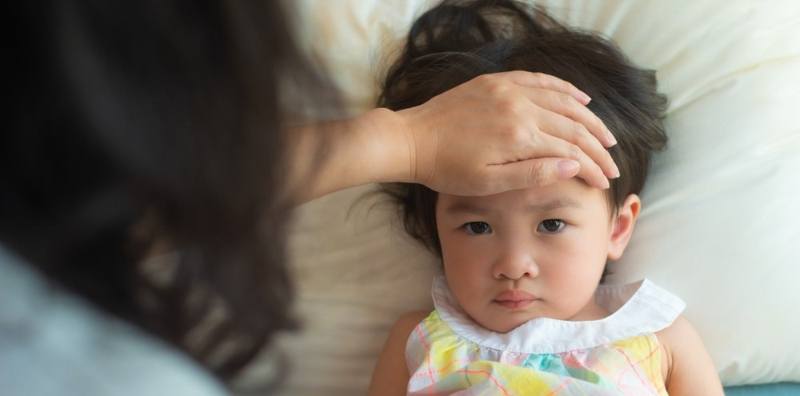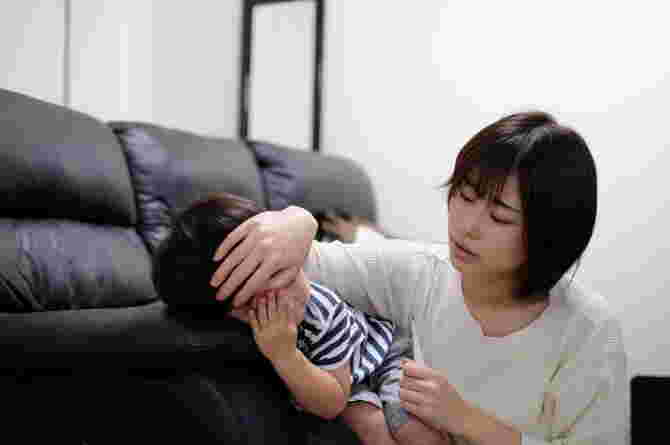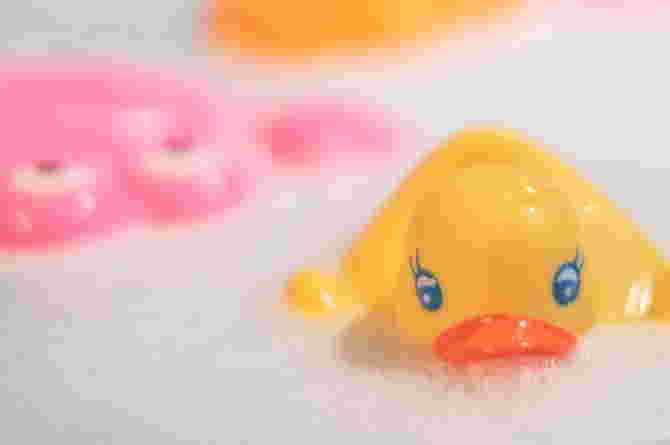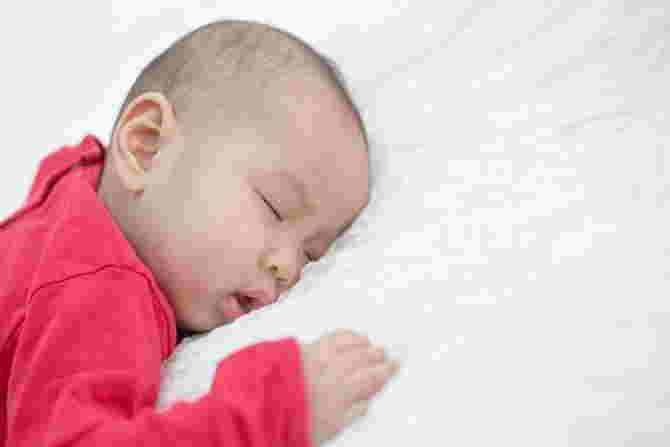Does your child have a fever? 7 things to do to bring down their fever

When caring for a child with a fever, they may not want to take medicine. Here are 6 natural ways to bring down their fever.
What is the medicine for a child’s fever? How can you tell by the child’s temperature that he or she has a fever? Find out here.
It is hard for a mother to see her child sick and struggling. As much as possible, we want them to have a strong body and be active in physical activities. It is emotionally painful to take care of a sick child, especially if they are still awake in the early hours of the morning due to a fever.
One thing that causes a lot of anxiety and worry for our parents is a child’s high fever. We are restless when we feel that they are feeling hot and their body is sluggish. We are especially anxious when the child is “fiery with fever”.
It’s natural for us to worry, but instead of panicking, we should be prepared for such situations and know what to do to bring down a child’s fever. It’s important to know the right medicine for fever in children 4 years old and below to ensure their safety and health. Here are some steps that can help reduce their fever and restore their vitality. Let’s start with simple things that can be done to bring down their fever and speed up their recovery.
▼Table of Contents
What is fever?
Fever occurs when the body temperature rises. According to science, fever depends on the body’s thermostat, which is dictated by a part of our brain called the hypothalamus. The hypothalamus knows the normal body temperature, which should be around 98.6°F or 37°C.
Aside from being sick, there are activities we do every day that can affect our normal body temperature. Like playing with children or exercising that burns calories and fats in the body, which can cause it to heat up slightly. Body temperature can also change depending on the climate or the time of day.
Some people have higher temperatures at night and lower temperatures in the morning. However, experts explain that an increase in body temperature from normal, called a fever, is a sign of illness.
Because fever is the body’s response to an infection or illness that it is fighting. Science further explains that having a fever is our body’s way of making it harder for germs that cause illness to stay and cause us more illness. That’s why it’s important to know what to do to lower a fever to maintain the health of our children. These steps can help regulate their temperature and restore their vitality. An important part of care is knowing what to do to lower a fever, especially in cases where immediate attention is needed.
What causes a child’s fever?

Caring for a child with a fever | Image source: iStock
For us adults, fever is often overcome by our bodies without the need for medication. But for children, especially babies, fever causes discomfort.
A fever in a child or infant, if left untreated or not treated promptly, can lead to dehydration , which is extremely dangerous for their small bodies.
According to Dr. Nicole Perreras , a pediatrician at Makati Medical Center , there are various causes of fever in children. It depends on the age.
“If a baby is three months and below and suddenly develops a fever, especially in the first 30 days or 29 days, it really needs to be assessed. But if the baby is older, for example three months to three years old, usually the most common cause of fever is a viral infection. Those are the so-called measles , diarrhea , cough and colds .
For older children, it also depends on the various signs and symptoms. Some people may ask, ‘is the baby just vaccinated?’. It could be that the baby has received a vaccine in the past 48 hours. So there are many things that could cause fever so it really depends. In general, those are the causes for age groups that parents need to focus on.”
But how can we tell if our child has a fever?
How can you tell if a child has a fever?
Placing your hand on the forehead and neck is one of the ways we are used to telling if a child or a person has a fever. But to be more accurate, there are three ways doctors recommend using a thermometer.
These methods differ based on which part of the child’s body the temperature is taken. And the temperature obtained for each part of the body may vary.
If a child’s temperature is taken using an oral thermometer, he or she is considered to have a fever when the temperature exceeds 100°F or 37.8°C.
If the temperature is taken using a rectal thermometer or in the buttock, the child is said to have a fever when the temperature obtained is above 100.4°F or 38°C.
While if the temperature is taken from the armpit or axillary as it is called, the child can be said to have a fever when it is above 99°F or 37.2°C. A child’s fever can be said to be high when it reaches 102°–104°F or 38.9°–40°C. When your child has a high fever, it is also important to know the right medicine for fever in children 4 years old and below to ensure their speedy recovery.
High fever in a child
Although it is scary to see a child’s high fever, it is not a measure of how serious the illness is. Because fever can fluctuate over time as a person sweats.
But for young children, a high fever is a cause for concern, especially if it is accompanied by rapid or difficult breathing. This is one of the signs that you should take your child to the doctor.
If the child is still an infant or 3 months old and has a fever, he or she should also consult a doctor immediately. There is nothing to worry about or say that the fever is not serious if the little child with a fever is still able to do the following:
It is important for parents to know what to do to bring down a fever, to ensure that their child is comfortable and does not develop complications. Proper care and knowledge of these steps will help maintain their child’s health.
- Still interested in playing.
- Able to eat and drink water properly.
- Alert and makes you smile.
- Has normal skin color.
- He looks fine once his body temperature or fever drops.
Recurrent fever in a child

Caring for a child with a fever | Image from Unsplash
Recurrent childhood fever is a fever that occurs multiple times over a period of time. It is sometimes described as episodic, meaning that this fever comes and goes.
This type of fever is commonly seen in young children, usually under the age of 5 (especially in infants and toddlers). The elevated temperature lasts for a few days and then subsides within a few hours.
One of the main symptoms is recurring fever in children in conditions called periodic fever syndromes.
Fever can occur for many different reasons. These causes may include:
- Viruses
- Bacterial infection
- Vaccination
However, recurring fever is not caused by a virus or bacterial infection.
Recurrent fever in children is one of the main symptoms of periodic fever syndrome. There are several types of periodic fever syndromes, including:
- Familial Mediterranean fever (FMF)
- Muckle-Wells syndrome and familial cold auto inflammatory syndrome
- Periodic fever, Aphthous-stomatitis, Pharyngitis, Adenitis (PFAPA) syndrome
- Tumor necrosis factor receptor associated periodic syndrome (TRAPS)
- Hyperimmunoglobulin D syndrome (HIDA)
- Neonatal onset multisystem inflammatory disease (NOMID)
Child’s fever at night: Should I wake him up?
If your child is asleep, do not wake your child just to take their temperature or give them fever medicine. A good night’s sleep is more important to the healing process than monitoring their temperature.
But if your child is sleeping restlessly, or breathing faster than usual or irregularly, you can check their temperature to decide if they need to be taken to the doctor or given medication.
As parents, we consider many things before giving our children fever medicine to lower their body temperature, especially if it is not recommended by a doctor. Are you one of those parents who don’t want to use medicine, especially for their toddlers? If so, there are ways you can do to lower your child’s fever or how to make your child’s fever go away without giving him medicine.
However, to be on the safe side, it is best to see your child’s doctor and follow the instructions they give your child. Taking steps to reduce fever without medication can also help them recover.
Medicine for child’s fever
Is the child’s fever not going down? Is the child’s feet and hands very hot? Does the child have a fever of 37.7?
Fortunately, there are some things you can do to reduce your child’s fever. Here are some home remedies for fever in children :
But first of all, we believe that when a child has a fever, they should first contact and seek advice from their pediatrician to find out what to do and the right medicine for their child’s fever.
How to get rid of a child’s fever?
1. What can be done to reduce a child’s fever? Make sure his clothes are fresh.
If he is not cold, it is not right to comb a child with a fever. Doing so will increase the temperature and make the body even hotter. His body needs to cool down, so reduce the layers of clothing he is wearing to lower his temperature.
2. Effective medicine for a child’s fever: Encourage him to drink fluids
Make sure a child with a fever drinks eight glasses of water. This will help the body release heat through urination.
3. How to reduce a child’s fever? Feed him plenty of fluids
A child will recover faster if he eats enough. This will strengthen his body so that he can recover faster. That’s why it’s best to feed him hot soup.
4. Home remedy for fever in children: Warm bath.
Avoid bathing your toddler in cold water. Bathe your child for a few minutes using lukewarm water.
5. Sponge bath
If he doesn’t want to take a bath, try a lukewarm sponge bath to bring down his fever. Then dress the child immediately so he doesn’t get cold.
6. Cold Compresses: Placed on the child’s forehead when there is a fever
Placing a cold washcloth on the child’s forehead, wrists, and areas of the body where the veins are close to the skin. Placing a cold washcloth on the child’s forehead when he has a fever can help him feel refreshed.
7. How to bring down a child’s fever: Offer him ice cubes
If he doesn’t want to drink, give him ice cubes or ice chips that he can suck on. This will help hydrate him and also cool him down.
Things to remember when giving your child fever-reducing medicine
If you are giving your child effective fever medicine, be sure to follow the doctor’s advice. One of the things you should know is the type of medicine you have, or what to buy. Dr. Perreras said,
“Before you give the medication, you should check the preparation. Sometimes parents say, ‘what I have is syrup’ but actually if you look at the box, it’s drops.
So when giving drops to children under 2 years old, the drug formulation is very concentrated. So 1 ml of a drop will have 100 mg versus syrups that are more dilute.
The others are 120 per 5 ml. the others 250mg per 5 ml. So number 1, be very careful. Be very careful of what you actually have or what you actually bought.”
The doctor added that the correct dosage for the child should also be considered. He said this is usually based on the child’s weight. He advised,
“But it’s best if you really ask your pediatrician what’s the safe range because if you overdose on paracetamol , depending on those, young children can have liver failure.
That’s also one reason for bringing a child to the emergency room if the child has drunk too much because that could have long-term effects.
One thing I can really recommend to parents is that before you give any medication, you should check the preparation and check the dose. Because it is not a drug that has no side effects if you overdose it.
“If you’re giving the proper dose, the proper time but still the temperature is not going down, the child may need to be assessed more. It may just be that there is another infection that is why the fever is not going away.”
Reducing a child’s fever: Should the medications be given together?
There are times when a child’s fever is accompanied by a cough and a cold. Sometimes we give our children a lot to drink in addition to fever medicine. Here is Dr. Perreras’ advice to avoid overdosing your child on medicine:
“It is best to consult your pediatrician because sometimes he will take into consideration if the cold medicines contain paracetamol.”
“Don’t give any medications that you haven’t heard from your pediatrician. Sometimes, it seems like you’ve maxed out the dose of paracetamol .”
Food for a child with a fever
Here are some foods for a child with a fever :
-
Breast milk
If your child is still breastfeeding, it will help your child’s fever. Your breastmilk will provide enough nutrition for your child and help them fight the fever.
In fact, your breasts will know if your baby is fighting an infection. The composition of your breastmilk will change to contain more antibodies against your baby’s fever.
-
Chicken Soup
It has a balanced amount of vitamins, minerals, and protein that are essential for fighting fever. Chicken also contains an amino acid called cysteine. It has anti-viral and anti-oxidant properties.
-
Honey
Pure organic honey has antimicrobial compounds. It also strengthens the immune system. It is also effective in treating coughs in children and adults.
Check out some more foods for those with fever here .
When should you consult your child if he or she has a fever?

Caring for a child with a fever | Image from Unsplash
Usually, if your child’s fever is lower than 38°C, you can use the six guidelines above to relieve your child’s discomfort.
Therefore, it is important to always have a body thermometer at home for times like these so you can monitor your child’s temperature.
Is your child’s hands and feet very hot? Does your child have a fever of 37.3? Depending on your child’s age, you can tell when you should be alarmed by their temperature. When it comes to this point, it’s best to talk to your pediatrician so they can give you the right prescription.
- From birth to three months of age – if his temperature reaches 38°C (100.4°F) or higher.
- Age from three months to six months – if his temperature has reached 39°C (102°F). Also note if he is irritable or constantly sleepy.
- From six months to two years old – if his temperature of 39°C does not subside within a day, you should take him to the doctor. Also observe if he shows any other symptoms such as rash, cough, or diarrhea . If he has any of the above symptoms, be sure to talk to his pediatrician immediately or take him to the nearest hospital.
For children two years and older, monitor their temperature. If it goes back to 40°C, call their pediatrician immediately or go to the nearest hospital to have them examined.
If your child’s fever lasts for three days or more, or does not subside with the help of home remedies and fever medication prescribed by the doctor, go to the nearest hospital so that he or she can be given a proper diagnosis and prescription.
Also take the child to the hospital immediately if his fever is accompanied by the following symptoms:
- pale or blue lips, tongue, or fingernails
- being anxious and constantly crying
- don’t want to drink water
- having seizures
- there are signs of dehydration (little urine, no tears when crying)
- stomach ache
- difficulty walking
- stiff neck
- difficulty breathing or wheezing
- purple bruise-like rashes
If you have any questions about your child’s fever, don’t hesitate to consult your child’s pediatrician.
Republished with permission from theAsianParent Philippines